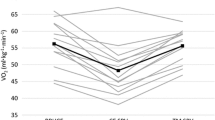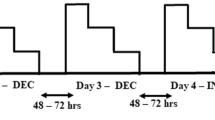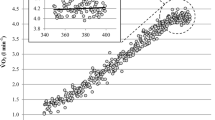Abstract
The concept of VO2max has been a defining paradigm in exercise physiology for >75 years. Within the last decade, this concept has been both challenged and defended. The purpose of this study was to test the concept of VO2max by comparing VO2 during a second exercise bout following a preliminary maximal effort exercise bout. The study had two parts. In Study #1, physically active non-athletes performed incremental cycle exercise. After 1-min recovery, a second bout was performed at a higher power output. In Study #2, competitive runners performed incremental treadmill exercise and, after 3-min recovery, a second bout at a higher speed. In Study #1 the highest VO2 (bout 1 vs. bout 2) was not significantly different (3.95 ± 0.75 vs. 4.06 ± 0.75 l min−1). Maximal heart rate was not different (179 ± 14 vs. 180 ± 13 bpm) although maximal V E was higher in the second bout (141 ± 36 vs. 151 ± 34 l min−1). In Study #2 the highest VO2 (bout 1 vs. bout 2) was not significantly different (4.09 ± 0.97 vs. 4.03 ± 1.16 l min−1), nor was maximal heart rate (184 + 6 vs. 181 ± 10 bpm) or maximal V E (126 ± 29 vs. 126 ± 34 l min−1). The results support the concept that the highest VO2 during a maximal incremental exercise bout is unlikely to change during a subsequent exercise bout, despite higher muscular power output. As such, the results support the “classical” view of VO2max.


Similar content being viewed by others

References
Amann M, Eldridge MW, Lovering AT, Stickland MK, Pegelow DF, Dempsey JA (2006) Arterial oxygenation influences central motor output and exercise performance via effects on peripheral locomotor muscle fatigue in humans. J Physiol 575:937–953
Ansley L, Schabort E, St Clair Gibson A, Lambert MI, Noakes TD (2004) Neural regulation of pacing strategies during 4-km time trials. Med Sci Sports Exerc 36:1819–1825
Bassett DR, Howley ET (1997) Maximal oxygen uptake: “classical” versus “contemporary” viewpoints. Med Sci Sports Exerc 29:591–603
Bassett DR, Howley ET (2000) Limiting factors for maximum oxygen uptake and determinants of endurance performance. Med Sci Sports Exerc 32:70–84
Bergh U, Ekblom B, Astrand PO (2000) Maximal osygen uptake “classical” versus “contemporary” viewpoints. Med Sci Sports Exerc 32:85–88
Brink-Elfegoun T, Kaijser L, Gustafsson T, Ekblom B (2007a) Maximal oxygen uptake is not limited by a central nervous system governor. J Appl Physiol 102:781–786
Brink-Elfegoun T, Holmberg H-C, Ekblom MN, Ekblom B (2007b) Neuromuscular and circulatory adaptation during combined arm and leg exercise with different maximal work loads. Eur J Appl Physiol (in press)
Crouter S, Foster C, Esten P, Brice G, Porcari JP (2001) Comparison of incremental treadmill exercise and free range running. Med Sci Sports Exerc 33:644–647
Day JR, Rossiter HB, Coats EM, Skasick A, Whipp BJ (2003) The maximally attainable VO2 during exercise in humans: the peak vs maximum issue. J Appl Physiol 95:1901–1907
di Prampero PE (2003) Factors limiting maximal performance in humans. Eur J Appl Physiol 90:420–429
Doherty M, Nobbs L, Noakes TD (2003) Low frequency of the “plateau phenomenon” during maximal exercise in elite British athletes. Eur J Appl Physiol 89:619–623
Dupont G, Moalla W, Matran R, Berthoin S (2007) Effect of short recovery intensities on the performance during two Wingate tests. Med Sci Sports Exerc 39:1170–1176
Eston R, Faulkner J, St Clair Gibson A, Noakes T, Parfitt G (2007) The effect of antecedent fatiguing activity on the relationship between perceived exertion and physiological activity during a constant load exercise task. Psychophysiology 44:1–8
Foster C, Green MC, Snyder AC, Thompson NN (1993) Physiological responses during simulated competition. Med Sci Sports Exerc 25:877–882
Foster C, Coye RB, Crowe A, Dumit M, Lettau S, Young H, Volkert P (1997) Comparison of free range and graded exercise testing. Med Sci Sports Exerc 29:1521–1526
Foster C, deKoning JJ, Hettinga F, Lampen J, La Clair KL, Dodge C, Bobbert M, Porcari JP (2003) Pattern of energy expenditure during simulated competition. Med Sci Sports Exerc 35:826–831
Foster C, deKoning JJ, Hettinga F, Lampen F, Dodge C, Bobbert M, Porcari JP (2004) Effect of competitive distance on energy expenditure during simulated competition. Int J Sports Med 25:198–204
Gonzalez-Alonso J, Calbet JAL (2003) Reductions in systemic and skeletal muscle blood flow and oxygen delivery limit maximal aerobic capacity in humans. Circulation 107:824–830
Hettinga FJ, deKoning JJ, Boersen FT, van Geffen P, Foster C (2006) Pacing strategy and the occurrence of fatigue in 4000 m cycling time trials. Med Sci Sports Exerc 38:1484–1491
Hill AV, Lupton H (1923) Muscular exercise, lactic acid and the supply and utilization of oxygen. Q J Med 16:135–171
Howley ET, Bassett DR, Welch HG (1995) Criteria for maximal oxygen uptake: review and commentary. Med Sci Sports Exerc 27:1292–1301
Karlsson J, Saltin B (1970) Lactate, ATP and CP in working muscles during exhaustive exercise in man. J Appl Physiol 29:598–602
Lacour J-R, Messonnier L, Bourdin M (2007) The leveling-off of oxygen uptake is related to blood bactate accumulation. Retrospective study of 94 elite rowers. Eur J Appl Physiol 101:241–247
Lambert EV, StClair Gibson A, Noakes TD (2004) Complex systems model of fatigue: integrative homeostatic control of peripheral physiological systems during exercise in humans. Br J Sports Med 39:52–62
Lucia A, Rabahan M Hoyos J, Hernandez-Capilla M, Perez M, San Juan AF, Earnest CP, Chicharro JL (2006) Frequency of the VO2max plateau phenomenon in world-class cyclists. Int J Sports Med 27:1–9
Mitchell JH, Sproule BJ, Chapman CB (1958) The physiological meaning of the maximal oxygen intake test. J Clin Invest 37:538–547
Noakes TD (1997) Challenging beliefs: ex Africa simper aliquid novi. Med Sci Sports Exerc 29:571–590
Noakes TD (1998) Maximal oxygen uptake: “classical” versus “contemporary” viewpoints: a rebuttal. Med Sci Sports Exerc 30:1381–1398
Noakes TD, StClair Gibson A (2004) Logical limitation in the “catastrophe” models of fatigue during exercise in humans. Br J Sports Med 38:648–649
Rauch HGL, StClair Gibson A, Lambert EV (2005) A signaling role for muscle glycogen in the regulation of pace during prolonged exercise. Br J Sports Med 39:34–38
Rossiter HB, Kowalchuk JM, Whipp BJ (2006) A test to establish maximum O2 uptake despite no plateau in the O2 uptake response to ramp incremental exercise. J Appl Physiol 100:764–770
Saltin B (1985) Hemodynamic adaptations to exercise. Am J Cardiol 55:42D-47D
Shephard RJ, Allen C, Benade AJS (1968) The maximum oxygen intake: an international reference standard of cardioprespiratory fitness. Bull World Health Organ 38:757–764
Snell PG, Stray-Gunderson J, Levine DB, Hawkins MN, Raven PB (2007) Maximal oxygen uptake as a parametric measure of cardiorespiratory capacity. Med Sci Sports Exerc 39:103–107
Spencer M, Bishop D, Dawson B, Goodman C, Duffield R (2006) Metabolism and performance in repeated cycle sprints: active versus passive recovery. Med Sci Sports Exerc 38:1492–1499
StClair Gibson A, Lambert MI, Noakes TD (2001a) Neural control of force output during maximal and submaximal exercise. Sports Med 31:632–658
StClair Gibson A, Schabort EJ, Noakes TD (2001b) Reduced neuromuscular activity and force generation during prolonged cycling. Am J Physiol 281:R187-R196
StClair Gibson A, Foster C (2007) The role of self tak in the awareness of physiological state and physical performance. Sports Med (in press)
Taylor HL, Buskirk E, Henschel A (1955) Maximal oxygen intake as an objective measure of cardio-respiratory performance. J Appl Physiol 8:73–80
Westerblad H, Allen DG, Lannergren J (2002) Muscle fatigue: lactic acid or inorganic phosphate the major cause? News Physiol Sci 17:17–21
Author information
Authors and Affiliations
Corresponding author
Rights and permissions
About this article
Cite this article
Foster, C., Kuffel, E., Bradley, N. et al. VO2max during successive maximal efforts. Eur J Appl Physiol 102, 67–72 (2007). https://doi.org/10.1007/s00421-007-0565-x
Accepted:
Published:
Issue Date:
DOI: https://doi.org/10.1007/s00421-007-0565-x



